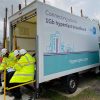Europe Offers Support to Local Community Broadband Projects
The European Commission (EC) has today moved to complement their Digital Agenda project, which aims to make broadband speeds of 30Mbps+ available to all EU homes come 2020, by launching a new “Connected Communities” initiative that offers additional funding and support to local community broadband partnerships and operators.
The initiative, which is partly funded by the now significantly diminished investment from the Connecting Europe Facility (CEF), aims to identify and support a number of “innovative pilot projects” for deploying high-speed broadband which can be replicated across the European Union.
Advertisement
Projects that are chosen will then be prioritized for “technical assistance” services under the CEF, which will be operating in partnership with both the EC (European Investment Bank and European Structural and Investment Funds) and the World Bank. Together these groups will help related projects to develop business models and advise on funding, some of which will of course be offered through the new initiative.
Precise details are a little unclear, although it’s already known that around 15% of the CEF’s €1 billion budget will go towards supporting broadband projects. Elsewhere the EU has around €453 billion available to all regions between now and 2020, which will be handled by the European Structural and Investment Funds (ESIF) and some of this will also go towards broadband schemes.
Neelie Kroes, EC Vice President, said:
“If you’re a local authority, a region, or a committed broadband activist, we are here to help you! We want to connect you to practical support and finance to help you achieve your vision for your community.”
Apparently any local, regional or national, public, semi-public or private entities can present a broadband project to the Connected Communities initiative, which must obviously be located in one or more EU Member State and meet some additional criteria.
Connected Communities – Eligibility Criteria
• Project must contribution to the Digital Agenda for Europe targets (i.e. to deliver high-speed broadband of at least 30 Mbps);
• Cover areas that will not be covered by other investors;
• Use advanced technology which is deemed most suitable to address the needs of the geographic area in question, taking into account social and economic factors;
• Technology best suited for the specific project, in terms of speed, transmission security, network resilience, and cost efficiency;
• A possibility to replicate the project in another country or region.
The first phase, to submit a project for review by the scheme, will be open until 15th October 2014 and after that the submitted proposals will be grouped into three categories, and the results will then be confirmed by 1st November 2014. Unfortunately that won’t be the end of this process because a second phase will open until 31st December 2014, with the aim of refining the information provided under the first phase.
Advertisement
Assuming a project makes it this far then it will need to be evaluated by the EC and Word Bank “experts” (expected around 28th February 2015) before receiving a proposal of technical assistance. Quite a long time to be waiting for an answer. Further details can be found on this FAQ page.
Mark is a professional technology writer, IT consultant and computer engineer from Dorset (England), he also founded ISPreview in 1999 and enjoys analysing the latest telecoms and broadband developments. Find me on X (Twitter), Mastodon, Facebook, BlueSky, Threads.net and Linkedin.
« BT’s Ultrafast FTTP Broadband Reaches Nearly 150,000 UK Premises


















































Comments are closed